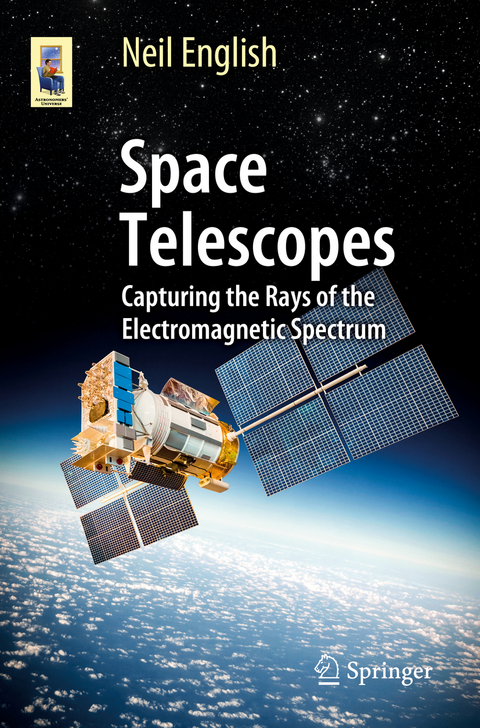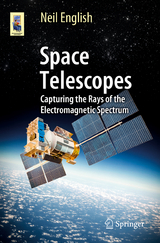Space Telescopes
Springer International Publishing (Verlag)
978-3-319-27812-4 (ISBN)
Only certain kinds of radiation can penetrate our planet's atmosphere, which limits what we can observe. But with space telescopes all this changed. We now have the means to "see" beyond Earth using ultraviolet, microwave, and infrared rays, X-rays and gamma rays.
In this book we meet the pioneers and the telescopes that were built around their ideas. This book looks at space telescopes not simply chronologically but also in order of the electromagnetic spectrum, making it possible to understand better why they were made.
Dr. Neil English is an Irish citizen with a BSc in Physics & Astronomy, and also a PhD in Biochemistry. He is a Fellow of the Royal Astronomical Society, and a regular contributor to Astronomy Now (the UK’s major astronomy magazine), as well as to Ireland's Astronomy & Space. Dr. English’s astronomical images have been published in various magazines and journals, including a full page in the June 2006 issue of Astronomy. Dr. English has, and continues to, make contributions to Cloudy Nights in the form of several detailed telescope reviews. He is the author of Guide to Mars (Pole Star Publications, 2003) and he has three books published by Springer: Choosing and Using a Refracting Telescope (2010), Choosing and Using a Dobsonian Telescope (2011), Classic Telescopes (2012). His fourth book with Springer is Grab ‘n’ Go Astronomy (2014). Dr. English currently has (among other instruments) a large 12-inch Dobsonian which he uses on the darkest, steadiest nights at his home in rural Scotland.
Acknowledgements.- Preface.- Chapter 1: Light: Nature's Great Information Superhighway.- Chapter 2: The Hubble Space Telescope - Tragedy and Triumph.- Chapter 3: Hubble - The People's Telescope.- Chapter 4: The Infrared Universe.- Chapter 5: The Gamma Ray Universe.- Chapter 6: The Universe Through Ultraviolet Eyes.- Chapter 7: The X-Ray Universe.- Chapter 8: Probing the Microwave Sky.- Chapter 9: Empire of the Sun.- Chapter 10: Measuring the Heavens.- Chapter 11: Looking to the Future: The James Webb Space Telescope.- Useful Websites on Space Telescopes.- Glossary.- Bibliography.- Index.
"English, a Fellow of the Royal Astronomical Society, takes the reader through an exploration of the discovery of the various spectrums, compositely the electromagnetic spectrum, which is used to study the cosmos through telescopes. ... this book is filled with fun information about the science and technology utilized to study the past and prepare for the future. Summing Up: Recommended. All readers." (R. I. Saltz, Choice, Vol. 57 (11), July, 2017)
| Erscheinungsdatum | 28.11.2016 |
|---|---|
| Reihe/Serie | Astronomers' Universe |
| Zusatzinfo | XII, 312 p. 103 illus., 88 illus. in color. |
| Verlagsort | Cham |
| Sprache | englisch |
| Maße | 155 x 235 mm |
| Themenwelt | Sachbuch/Ratgeber ► Natur / Technik ► Weltraum / Astronomie |
| Naturwissenschaften ► Physik / Astronomie ► Angewandte Physik | |
| Naturwissenschaften ► Physik / Astronomie ► Astronomie / Astrophysik | |
| Schlagworte | Astronomy, Observations and Techniques • Electromagnetic Spectrum Discoveries • Extraterrestrial Physics, Space Sciences • History of Science • Hubble Telescope • James Webb Telescope • Microwave Telescopes • NASA Space Telescope History • orbital telescopes • Physics and Astronomy • Popular Science in Astronomy • Solar Space Telescopes • Space-based Telescope Missions • Telescope Engineering • Using Space Telescopes for Cosmology |
| ISBN-10 | 3-319-27812-6 / 3319278126 |
| ISBN-13 | 978-3-319-27812-4 / 9783319278124 |
| Zustand | Neuware |
| Haben Sie eine Frage zum Produkt? |
aus dem Bereich




